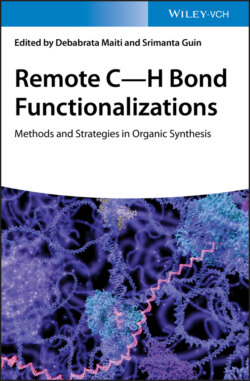Читать книгу Remote C-H Bond Functionalizations - Группа авторов - Страница 20
2.2.4 Sulfonic Acid Derivatives
ОглавлениеIn 2015, Maiti and coworkers developed the first meta‐C–H activation of benzylsulfonic acid derivatives using aforementioned commercially available the 2‐hydroxybenzonitrile directing template with high and controllable mono‐selectivity (Scheme 2.35a) [38]. Thus, meta‐selective homo‐diolefination and sequential hetero‐diolefination of benzylsulfonyl ester derivatives were made possibly with this protocol, providing a novel method for the synthesis of hetero‐dialkenylated products that are difficult to access using conventional methods. Notably, the directing template could be converted to an alkenyl group using modified Julia olefination conditions (Scheme 2.35b).
Scheme 2.35 (a) meta‐C–H olefination of benzylsulfonic acid derivatives. (b) Elaboration of product via olefination.
Source: (a) Modified from Bera et al. [38].
Subsequently, Maiti and coworkers also achieved the meta‐C–H olefination of 2‐phenethylsulfonic acid derivatives using the similar approach as the benzylsulfonic acid using the N‐formyl glycine (For‐Gly‐OH) ligand (Scheme 2.36a) [14]. Notably, sequential meta‐selective hetero‐diolefination was also feasible with these substrates, and the deprotection and recovery of the directing template were successfully realized under basic conditions (Scheme 2.36b).
Scheme 2.36 (a) meta‐C–H olefination of 2‐phenethylsulfonic acid derivatives. (b) Removal of directing template.
Source: (a) Modified from Modak et al. [14].
In 2017, Maiti and coworkers disclosed the first pyrimidine‐based template, which is effective for meta‐C–H olefination of benzylsulfonyl and 2‐phenethylsulfonyl esters, leading to an unconventional formation of α,β‐unsaturated aldehydes with benzyl‐protected allyl alcohols (Scheme 2.37) [39]. This novel pyrimidine‐based template was also utilized for the production of β‐aryl aldehydes and ketones, using allyl alcohols through meta‐C–H alkylation of benzylsulfonyl and 2‐phenethylsulfonyl esters.
Scheme 2.37 meta‐C–H olefination and alkylation of benzylsulfonyl and 2‐phenethylsulfonyl esters.
Source: Modified from Bag et al. [39].
In the same year, the Maiti group introduced the novel 8‐nitroquinoline‐based directing template for meta‐C–H functionalization of benzylsulfonyl esters via strong σ‐coordination, ensuring the potential formation of a stable palladacycle (Scheme 2.38) [36]. The protocol enabled both meta‐C–H olefination and acetoxylation, which could be scaled up and diversified to synthetically important compounds in late stage.
Scheme 2.38 meta‐C–H olefination and acetoxylation of benzylsulfonyl esters.
Source: Modified from Dutta et al. [36].
In 2017, Maiti and coworkers also developed the XPhos‐supported Rhodium catalysis of meta‐C–H olefination of benzylsulfonic acids with the assistance of 2‐hydroxy‐4‐methoxy benzonitrile template (Scheme 2.39) [22]. Complete mono‐selectivity was observed for this reaction, and a range of olefins and substituents at all positions of the aryl ring were found to be tolerated.
Scheme 2.39 Rh‐catalyzed meta‐C–H olefination of benzylsulfonyl esters.
Source: Modified from Bera et al. [22].
The development of efficient methods for the synthesis of organofluorine compounds is of great interest. Werz, Zanoni, Maiti, and coworkers achieved the first meta‐C–H perfluoroalkenylation of benzylsulfonic acid derivatives using the pyrimidine‐based template with several commercially available perfluoroolefins (Scheme 2.40) [24]. The substrate scope was broad and a high degree of compatibility with perfluoroolefins of different nature was also observed.
Scheme 2.40 meta‐C–H perfluoroalkenylation of benzylsulfonyl esters.
Source: Modified from Brochetta et al. [24].
In 2019, Paton, Maiti, and coworkers developed the Palladium(II)‐catalyzed meta‐selective C–H allylation of benzylsulfonyl esters using synthetically inert acyclic internal olefins as allylic surrogates (Scheme 2.41) [27]. The pyrimidine‐based directing group proved to be the key factor to facilitate the olefin insertion by overcoming inertness of the typical unactivated internal olefins for meta‐selective C–H activations. A broad scope of substrates with wide functional‐group tolerance was viable with this method to give good to excellent yields of products with exclusive E stereoselectivity.
Scheme 2.41 meta‐C–H allylation of benzylsulfonyl esters.
Source: Modified from Achar et al. [27].
Direct transformation of a CH bond to a carbon–heteroatom bond is highly important since their prevalence in complex natural products, pharmaceuticals, and agrochemicals. In 2016, Sunoj, Maiti, and coworkers achieved meta‐C–H oxygenation of benzylsulfonyl esters by using an oxygenating agent PhI(OOCR3)2 (Scheme 2.42) [40]. Notably, the formation of hydroxylated or acetoxylated molecules was obtained under similar reaction conditions with the variation of R (R = H, F) on the common agent PhI(OOCR3)2. Importantly, the approach had also been applied to the synthesis of unsymmetrically substituted phenols.
Scheme 2.42 meta‐C–H oxygenation of benzylsulfonyl esters.
Source: Modified from Maji et al. [40].
In 2017, Maiti and coworkers disclosed a pyrimidine‐based template assisted meta‐C–H cyanation of benzylsulfonyl and 2‐phenethylsulfonyl esters using stoichiometric amount of copper(I) cyanide as the cyanating agent (Scheme 2.43) [41]. The meta‐cyano products are useful building blocks for synthesis of complex natural products as well as many drug molecules, and the synthesis of pharmaceutically valuable precursors was demonstrated by using this novel protocol.
Scheme 2.43 meta‐C–H cyanation of benzylsulfonyl and 2‐phenethylsulfonyl esters.
Source: Modified from Bag et al. [41].
Deuterium‐labeled compounds are important for pharmaceutical industry and kinetic studies of reaction mechanisms. In 2019, Werz, Maiti, and coworkers reported the Pd‐catalyzed meta‐C–H deuteration of benzylsulfonyl esters derivatives using readily available deuterium source such as deuterated acetic acid, assisted by readily removable pyrimidine‐based template (Scheme 2.44) [26]. It was demonstrated that the template morphology was crucial for effectivity and selectivity of this remote CH bond activation. Meanwhile, Yu, Dai, and coworkers also achieved an isolated example of meta‐C–H deuteration of benzylsulfonyl esters using pyridine‐based template.
Scheme 2.44 meta‐C–H deuteration of benzylsulfonyl esters.
Source: Modified from Bag et al. [26].
In 2017, the group of Maiti achieved an unprecedented meta‐silylation and ‐germanylation of benzylsulfonyl esters by employing a nitrile‐based phenolic directing template using readily available hexamethyldisilane as the silylating agent (Scheme 2.45) [42]. Notably, meta‐silylation could be extended for 2‐phenylethanesulfonic acids and 3‐phenylpropane‐1‐sulfonic acid. Several examples of photosynthetic elaborations were attempted to demonstrate the synthetic utility, such as a formal synthesis of TAC101, a potential drug for the treatment of lung cancer.
Scheme 2.45 meta‐C–H silylation and germanylation.
Source: Modified from Modak et al. [42].
